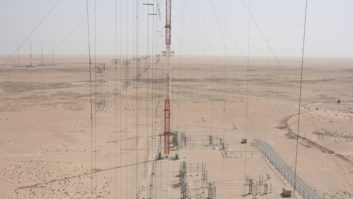OTTAWA — During the height of the Cold War (1947–1991), the shortwave radio bands were alive with international state-run broadcasters; transmitting their respective views in multiple languages to listeners around the globe.
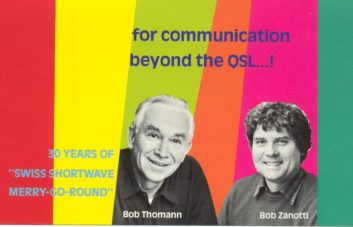
The western bloc’s advocates were led by the BBC World Service, and included Voice of America, Radio Liberty/Radio Free Europe, Radio Canada International and a host of influential European broadcasters. The eastern bloc’s de facto team captain was the USSR’s Radio Moscow (with its unique hollow, echoing sound), supplemented by broadcasters in Soviet satellite countries (like East Germany’s Radio Berlin International) and allies like Fidel Castro’s Radio Havana Cuba.
Then 1991 arrived, and the Cold War apparently ended with the fall of the Soviet Union and the destruction of the Berlin Wall.

In the seeming peace that followed, many governments no longer saw the sense in spending millions on multi-megawatt transmitters and vast antenna farms to keep broadcasting their messages globally.
The leader among them, the BBC World Service (BBCWS), trumpeted the web and webcasting as modern, cost-effective alternatives to expensive shortwave broadcasting (along with satellite radio and leasing local FM airtime in the countries they used to broadcast to). This is why the BBCWS ceased shortwave transmissions to North America and Australia in 2001 and Europe in 2008, while retaining SW broadcasts in less-developed parts of the globe.
[Read: Sentech Shuts Meyerton Shortwave Site]
“It is my understanding that it was the BBC that started to spread the notion that shortwave was dying or already dead,” said Bob Zanotti; co-host of Swiss Radio International’s popular “Listener Mailbag” show “The Two Bobs” from 1970 to 1994. (He now runs the English-language Swiss information webcaster www.switzerlandinsound.com)
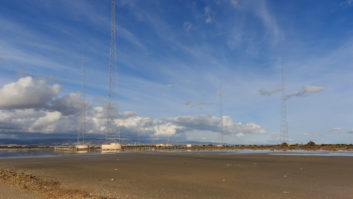
“Swiss Radio International accepted this uncritically and was the first to announce the complete closure of its shortwave operations. Later, others like Radio Netherlands, Radio Sweden, Deutsche Welle and Austrian Radio followed suit.” So did Radio Canada International, Radio Australia, Radio Budapest, Radio Portugal, Radio Finland, Radio Denmark and even Radio Moscow. Renamed Voice of Russia in 1993 (and Radio Sputnik in 2014), this Eastern European powerhouse left the shortwave bands for good on April 1, 2014.
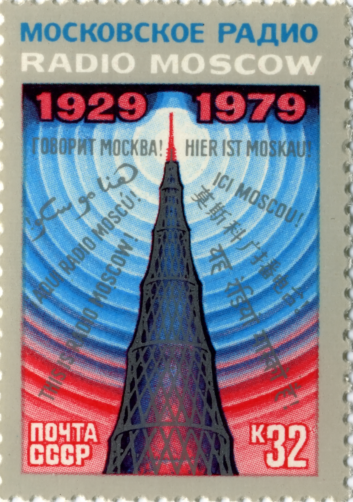
Now it is 2019, and another Cold War has resumed with the West on one side and Russia, China, Iran, and North Korea on the other. But this time, many of the powerful international voices that brought Western news and views to nondemocratic countries are now only found on the web — where adversarial governments can easily block them.
“In my opinion, the abandonment of shortwave for international broadcasting was a mistake,” said Zanotti. “It was based on what many believed to be the end of the Cold War. However, events since then have proved that to have been a false (and even foolish) notion.”
“Today, there is very little uncensored information available on shortwave. Classic information and entertainment are also practically nonexistent,” he added. “The clever Chinese strategy seems to have been to wait for all the major western shortwave players to leave the scene, and then move in to fill the vacuum, making China Radio International virtually the only shortwave show in town.”

THE SEDUCTION OF THE WEB
The official reason the BBC World Service moved away from shortwave (although not entirely) was because the web was where most 21st century listeners were going.
“Digital technology has undoubtedly come of age. Now the hype over the internet revolution is behind us, the real benefits to businesses and to broadcasters are shining through,” declared then BBC World Service Director Mark Byford when he delivered the 2001 Cornwall Lecture.
“For the World Service, it means that people who could never receive our radio transmissions in the 42 languages can now listen to live output, or catch that program they particularly want to hear, at a time when it suits them, anywhere in the world.”
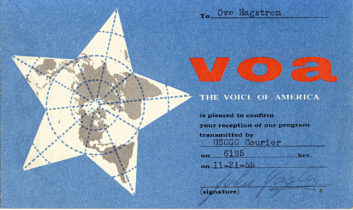
“For media users, the internet unlocks a whole new world of information tailored to you as an individual,” Byford continued. “You can listen to a program when you want. You can have your say to a global audience.”
The BBC World Service’s web-first focus was subsequently adopted by many state-run broadcasters, who also cut back on their shortwave broadcasts (or left the band entirely) in favor of the web.
There was logic to this argument: “Large government broadcasters, have always tried to reach the ‘influencers’ in a country; those who might eventually help guide a country’s policy and international relationships,” said Thomas Witherspoon, editor of the shortwave listener website www.SWLingPost.com. “And the great majority of these influencers, according to audience research, have moved to social media and the internet as a source of information.”
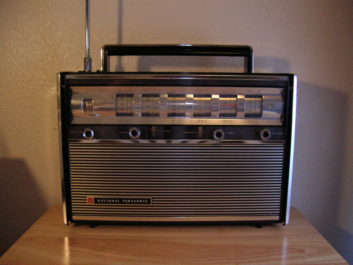
The unofficial reason for so many governments leaving shortwave was to save money. “Shortwave broadcasting is expensive when compared with streaming or ‘broadcasting’ online,” Witherspoon said. “The power requirements of shortwave transmitters pumping out 50, 250, or 500 kW is substantial, and the infrastructure — the large antennas, feedlines, transmitters, power supplies — all require regular maintenance from expert technicians.”
Money was a major factor in the death of Radio Netherlands (in Dutch: Radio Nederland Wereldomroep), which was succeeded in other media (including the web) by RNW Media. But it wasn’t the only factor; populism also played a part.
“In 2012, public international radio in The Netherlands had to stop broadcasting, said Jennifer Bushee, RNW Media’s communication and stakeholder manager. “The Dutch government had decided to cut the subsidy to Radio Nederland Wereldomroep by 70%. The broadcaster was no longer seen as relevant, and there was a real effort to reduce subsidies from conservative or even more right-wing politicians … So we were cut off and had to go off the air.”
ASSESSING THE IMPACT

It is true that the web has changed the very nature of international communications. In the past, only the most powerful broadcasters could address the world, simply because it took massively expensive transmission farms to send the signals out. Today, anyone can do it from the convenience of their laptop computer and their local ISP.
This said, moving away from shortwave has plunged many once-distinct international broadcasters into obscurity — and in some cases, into extinction — precisely because they are competing directly with the millions of streaming services the internet has to offer. (This extra choice has certainly cut into the audience for shortwave radio, as has the growing variety of multiple media sources in countries around the world. This said, shortwave audiences were and are not measured by any ratings services, so evidence as to their decline is mainly anecdotal.)

“What really disappoints me are the international broadcasters who have stopped shortwave in favor of internet, usually because it’s much less expensive to operate, but ostensibly because the internet is ‘new technology,’” said Jeff White, general manager of the commercial United States-based shortwave broadcaster WRMI Radio Miami International. “Then they end up some months later shutting down their internet broadcasts and websites also, leaving the world with no means of hearing official broadcasts from these countries. This is particularly the case in Europe.”
THE SHELL OF A TITAN
In its Cold War heyday, Radio Canada International was one of the world’s most listened-to international shortwave broadcasters. Popular programs like “The SWL Digest” made RCI announcer/producer Ian McFarland into a bona fide shortwave star. (Even today, airchecks of the SWL Digest are being shared online.) They were broadcast from RCI’s Atlantic Ocean transmission farm in Sackville, New Brunswick.

Sackville’s North American/European reach was so good that many international broadcasters rented it as a relay site. (Historical note: According to RCI’s website, the first
Montreal home of the then-named Canadian Broadcasting Corp.’s International Service was “a former brothel and garment factory.”
Founded in 1942 during World War II, RCI prospered until the 1991 thaw in the Cold War. Then the cuts made by successive cash-hungry governments began: First the number of broadcast languages were cut back, followed by the replacement of RCI-produced content with domestic programs made by the Canadian Broadcasting Corp.
Eventually some RCI-produced content returned, but the cuts continued: By 2012, an 80% cut in federal funding forced RCI to abandon SW and satellite radio broadcasting entirely and retreat to www.rcinet.ca. The famed Sackville transmission farm was torn down two years later.
“In the wake of the 80% budget cuts, RCI is down to 23 staff members, editor-in chief included and is now part of Radio-Canada’s News department,” said Soleïman Mellali, RCI’s web editor-in-chief. (Radio-Canada is the country’s French-language public broadcaster.) “Content is produced on weekdays to cover all seven days.”
It took an extensive amount of staff training to get RCI’s web content to its current level,” said Mellali. “The team had a solid radio background but felt uneasy about RCI’s transition to web-only, which has left them a bit off kilter.”
The effort has paid off. According to Mellali, RCI’s number of monthly visitors has tripled since its web was made more user-friendly. “Social media participation has (also) increased,” he said. “On Facebook, for instance, we’ve shot up from 1,200 fans to over 18 000.”

Nevertheless, RCI’s transformation into a web-only service has substantially narrowed its scope, said McFarland, and the service’s ability to reach listeners worldwide.
“When RCI deserted the shortwave bands in favor of the web, the service’s philosophy also changed,” McFarland told RWI. “It went from appealing to basically anyone who was interested in Canada, in what was happening here and our relationship with the rest of the world, in favor of broadcasting to people who might be interested in immigrating to Canada.”
“Meanwhile, the computer was now the only way to hear broadcasts from Canada: Listeners in African, Asian and European countries who tuned to Canada on cheap shortwave receivers were no longer a segment of the worldwide listening audience that RCI was interested in reaching,” he added. “This change in target audiences was a great slap in the face for RCI’s long time and very loyal listeners around the world who held Canada in very high esteem for many decades of successful broadcasting on shortwave.”
Other international broadcasters who have abandoned shortwave for the web have likely experienced this loss. The reason: Access to “high-speed internet is not a universal thing,” said Colin Newell, a shortwave enthusiast since 1972 and operator of the shortwave listener site www.DXer.ca. (“DX” is an old Morse Code abbreviation standing for “long distance.”) “It is surely widespread and available in the oddest of places, but it is not universal or universally reliable.”
VULNERABLITY TO CENSORSHIP
When it comes to the fallout from international broadcasting moving to the web, there is one fact that everyone agrees on; namely the internet’s vulnerability to censorship by hostile powers.
Back when international programming was delivered via multiple high-powered shortwave transmitters using many locations and shortwave frequencies, “jamming of broadcasts was an expensive and often ineffective method of blocking ‘the message,’” said Newell. Today, “jamming is as simple as a few clicks of a mouse on a national internet service. Full scale censorship is a significantly easier technological exercise.”
The bottom line: Today’s international broadcasters are nowhere near as capable as their Cold War predecessors were in getting messages through to the “other side” — and those who rely solely on the web can’t guarantee content delivery at all.
This is a textbook case of irony. By eschewing shortwave for the web, many international broadcasters have lessened their ability to serve their target audiences at all times; and in some cases, eliminated this capability entirely.
Take RCI: During the Cold War, its shortwave signals managed to reach listeners in the Soviet bloc. But today? Should he ever want to, Vladimir Putin could cut RCI off from Russian audiences in seconds.
Now it is theoretically possible that RCI could return to shortwave broadcasting. But this would require building a new transmission farm.
The demolished Sackville site isn’t available. Several New Brunswick Mi’kmaq indigenous communities purchased its cleared 90-hectares in 2017 to add to the Fort Folly First Nation reserve. But even if it were, the Canadian government would be unlikely to spend the money required to build a replacement shortwave facility. This is likely true in other countries that have demolished their shortwave transmission sites as well.
The inescapable conclusion: Moving to the web has fundamentally compromised international broadcasting’s ability to do its job, compared to what it could do back in shortwave’s glory days. And unless something happens to motivate governments to reinvest in expensive shortwave broadcasting, this will remain the case from now on.
James Careless reports on the industry for Radio World from Ottawa, Ontario.







